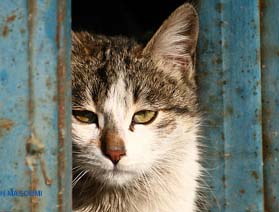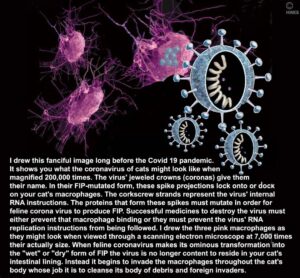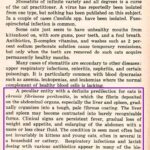Feline Infectious Peritonitis (FIP)
What Happened, Why It Happened, What Will Happen To My Cat, And What Are My Options?
Ron Hines DVM PhD
Ancient History
A long time ago, a Latin teacher at Mount Holyoke College who loved cats decided to change her profession. She enrolled in the best American veterinary college of the time, Cornell, and later took a position at the best American veterinary hospital of the time, Angell. She became their first veterinary feline medicine specialist. In 1962, this veterinarian, Jean Holtzworth, reported a perplexing and always fatal disease of cats among the many she examined. She named it “chronic fibrinous peritonitis”. Two years later, a veterinarian at Penn Vet reported on a cat with a similar disease. You can read both articles here:
Humans have lived with house cats for about 8,000 years and written about them for centuries. It is unlikely that a disease as serious as FIP would have gone unnoticed and unrecorded for that long. I believe that an important coronavirus virus mutation probably occurred in the late 1950s. Some propose that the common, more benign intestinal form of coronavirus of dogs and the more benign intestinal coronavirus of cats met and combined. (read here) As you all now know from another coronavirus, COVID-19, all coronaviruses are opportunistic, constantly changing who they infect, what organs they prefer and the severity of the disease they produce to their advantage. (read here) Without human intervention, it was highly unlikely that a dog suffering from a coronavirus infection and a cat suffering from a coronavirus infection would have met.
Today, veterinarians call the widespread and rarely dangerous intestinal (enteric) coronavirus of cats FCoV (=feline enteric coronavirus aka FECV) and its dangerous mutated form, FIPV (feline infectious peritonitis virus). When coronavirus mutation events occur, it is usually the viruses cell-seeking spike proteins that change their choice in which the cells they prefer to attack. (read here) That something like that had occurred in cats was proposed in 1996 by a group including Dr. Niels Pedersen at Davis. (read here) In 2009 he confirmed it. (read here)
It’s a general rule of virology is that when a virus accomplishes a mutation that is in its interest, the new mutation becomes the prevailing form. However, that has not been the case with the FIP coronavirus. The mild intestinal FCoV form of the cat coronavirus is still the prevailing form worldwide. It is never in a virus’s best interest to kill the host it inhabits, only to insure it is easily spread to new cats. A virus’only other option is to have a dense protective shell to allow it to persist in the environment, that is the strategy of the cat panleukopenia virus. Most veterinarians and research scientists currently believe that the mutated FIPV form of the cat coronavirus must arise anew from the mild intestinal FCoV form in every new cat that becomes ill with FIP. In most cats, that mutation probably never occurs. We currently believe that in perhaps 8-10% of cats it does occur. Of those cats, some will overcome the virus on their own and survive, and some will not. Until the discoveries of Dr. Pedersen and his team at the veterinary school in Davis, California, all cats that began to exhibit ill health eventually perished. Genetic factors unique to your cat might be another factor determining which cat does and which cat doesn’t develop FIP. We really do not know. It is also known that experimentally transferring the mutated FIPV coronavirus from an ill cat to a healthy cat produces FIP in the majority of cats in which that was done. (read here)

How Common Is The Ordinarily Mild Intestinal Form of Feline Coronavirus?
The ordinary, mild, feline coronavirus (FCoV) is quite common in cats throughout the world. Some studies suggest that almost half of the world’s house cats have been exposed to it. In some urban areas, up to nine out of ten cats examined had encountered the virus in the past. We know that because they had anti-corona antibodies in their blood. However, which cats actually get sampled is quite important in determining the results. (read here, here, here & here) In those studies, the number of FCoV-positive cats living in group situations was much higher than in those living in individual households. Cats in remote, isolated areas of the world apparently live their lives free of coronavirus. (read here & here)
Detection of a prior exposure to the FCoV virus through the common antibody-based tests veterinarians use does not necessarily mean that the virus is still present in your cat. And lack of antibody can also occur early in a true FCoV infection. Whatever the actual numbers, the virus is considerably more common than veterinarians would like it to be. When cats are not crowded closer together than Mother Nature intended them to be, or, when your multi-cat household has a stable reasonably sized population, both the mild form of feline coronavirus and the mutated FIP form are unlikely to be significant problems. Only ~4% of the native wild cats of Europe have antibodies against feline coronavirus that shows they have met a coronavirus – and that was probably through a chance encounter with a domestic cat. (read here)
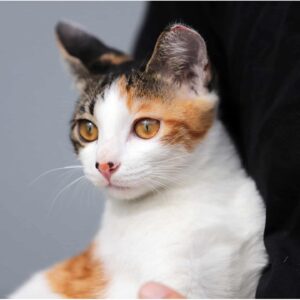
What Sort Of Illness Might The Mild Intestinal Form of Feline Coronavirus (FCoV) Cause In My Cat?
The mild form of coronavirus is most commonly seen in cats that are less than two years of age. Many cats, probably most, show no health-related signs when infected by this infection. But in those that do, a few days of mild diarrhea or loose stools is generally all that occurs. Most cats eventually eliminate this form of the coronavirus from their bodies – although some research veterinarians suspect that elements of the virus might linger on in a dormant or replication-defective, provirus state. We and our cats all carry provirus in our bodies. They generally cause us no harm. Some disagree with that opinion; however, they offer no evidence to support it. (read here)
Is My Cat’s Age Important When Ordinary Coronavirus Mutates Into Its Dangerous FIP Form?
Yes.
The majority of cats that contract FIP are young – usually between three and sixteen months of age. Over half are less than one year old, with the average age in one report being 9.7 months. In one California study, laboratory-bred cats developed increased resistance to FIP infections between 6 and 12 months of age. That said, FIP does occasionally develop in considerably older cats. Some veterinarians suspect that the more experienced immune systems of older cats are more likely to nip coronavirus mutants in the bud (destroy them before they can proliferate). Others, that the virus is less likely to mutate in older cats. Still other that still unknown factors are involved. (read here)

Is There More Than One Form Of FIP?
Yes.
Veterinarians recognize two basic forms of FIP, the “wet” form and the “dry form”. In the wet form, inflammatory fluids leak from the surface of your cat’s abdominal and/or chest organs. In the dry form, inflammation occurs within body organs without the production of excess fluids. Occasionally, signs of both forms are present in the same cat.

The “Wet” or Effusive Form Of FIP
This was the first form of FIP that early veterinarians like Jean Holzworth recognized. In this effusive or wet form of FIP, fluid builds up in your cat’s chest or abdomen, or both, as the surfaces of various organs become inflamed. This leaked fluid is primarily the result of the cat’s immune system attacking what it perceives as a threat from a foreign invader (the presence of proteins that do not belong in the cat’s body = antigens). Most veterinarians believe that this fluid buildup (an exudate) is not due to any direct damage that the virus causes to the cat’s body cells that it inhabits. It is the cat’s own cytokine-driven inflammatory response that liberates this mixture of fluid (blood serum) and proteins (globulin & fibrin) as well as white blood cells that would normally be confined to your cat’s blood stream. This fluid has a characteristic thick (“fibrinous”) consistency, usually with a yellow-tinged appearance, that makes my heart sink when I see it aspirating slowly into my syringe. (read here)
Your veterinarian will probably tap (withdraw) and examine the fluid to confirm suspicions, and then run tests to confirm that the liquid is indeed an exudate. On X-rays, this liquid has a characteristic granular appearance (a “ground glass” look). When fluid is found in your cat’s abdomen that is not that distinctive, causes besides FIP that might pass through your veterinarian’s mind, Lymphoma tumors, heart, liver disease or even a ruptured bladder are occasionally the underlying cause of abdominal fluid. Other laboratory tests rule those causes out. When the fluid is in a cat’s chest (a pleural effusion) other tests distinguish inflammatory fluid (exudate) from lymphatic chyle. When a cat has fluid accumulated in its chest, besides difficulty breathing, your veterinarian might remark that your cat’s heart sounds are muffled – difficult to hear through his/her stethoscope (difficult to auscultate). When a cat’s liver is involved, its gums might have a slight yellowish tinge to them (jaundiced). When effusive FIP occurs in a kitten, the youngster may just appear to fade away or have ceased to grow normally.

The Dry Form Of FIP, aka The Non-effusive, Pyogranulomatous Form
Granulomas are abnormal concentrations of immune system cells that gather around objects and disease organisms that the body is attempting to wall off or destroy. When FIP coronavirus-infected cells are primarily located diffusely within organs, this is the way a cat attacks them and attempts to wall them off. It might be in primarily in your cat’s liver, or its eyes, its brain, kidneys, or its lymph node(s), where these events occur most severely, or it might be in a combination of any or all of them. Needless to say, the symptoms are highly variable. Veterinarians call it the “dry” form of FIP because unlike the effusive form, excess fluid does not accumulate – or, if some does, it doesn’t predominate. The dry form is sometimes called the “parenchymatous” form of FIP. The functional cells of various organs are called its parenchyma.
These changes brought on by the dry form of FIP tend to begin gradually in your cat. They are all non-specific, that is, they could have many non-FIP-related explanations. Inflammatory changes in an eye(s) (uveitis) is a “textbook” (very common, classic) symptom of the non-effusive or dry form of FIP. Because of that, it will probably set off FIP alarm bells in your veterinarian’s mind earlier than most. That is particularly true when it is accompanied by other nervous system or eye changes. Those neurological problems might include lameness, seizures, or just a tipsy unstable rear end gait (ataxia). In both forms of FIP, it is not unusual for a cat’s owner to tell me that their pet experienced a major life stressing event within the previous few months. Events such as boarding, the addition of a new cat(s) to the family, a move, a rival cat in the neighborhood, or some other issue that was thought to have been resolved. Another typical history is that the cat was recently obtained from an animal shelter, a cat group home or a private cattery. (read here & here)

How Is The Common Milder Coronavirus (FECV) Transmitted Between Cats?
The much more common, much milder, non-mutated FCoV virus form of the cat coronavirus lives in the cells that line your pet’s intestine. When released, these virus pass out through your cat’s feces in large amounts. (read here) Cats grooming each other or sharing a litter box are thought to be the most common ways this virus transfers to another cat. Although no one has documented the survival time of the coronavirus of cats in the environment, coronavirus in general survive in the environment for only a few days – at the most. So, most veterinarians do not believe that contaminated objects in your cat’s household are a source of many (if any) infections. That said, frequently sanitizing and changing the litter in the boxes of multi-cat households is always a good idea. When you contemplate introducing a new cat into your household, a PCR test (FCoV RT-PCR) of its feces can tell your veterinarian if there are currently FCoV virus in its stool. However, FCoV virus shedding in cats is often intermittent. And, early in infections, the test results might be negative, even when the virus are already present in the cat’s stool – but in numbers too low for the PCR test to detect.
How Is The Dangerous FIP-Mutated Coronavirus Transmitted Between Cats?
Veterinarians do not believe that natural transmission of the already-mutated FIP coronavirus from cat to cat occurs. FIV-infected cats are known to shed little or no mutated virus in their stools, saliva or secreted fluids. (read here & here) Most veterinarians currently believe that every case of FIP requires a new mutation of the common FCoV virus after it infects a new cat. One article disputed that. However, no one was able to duplicate their results. (read here) Yet, the complex interactions between this virus and a cat’s immune system, the innumerable ways viruses can mutate, and every cat’s unique genetics make absolute statements unwise. Few things in veterinary medicine are absolute. (read here)

How Long After This Mutation Occurs Might My Cat Become ill?
I mentioned earlier that the vast majority of cats that are exposed to ordinary feline coronavirus never become seriously ill. When the virus stays in your cat’s intestines where it belongs, the most you might see is a short period of soft stools or diarrhea. Infection of the cat’s intestinal lining cells (its enterocytes) are most likely immediate after a cat ingests the coronavirus. But it can take a few days before the viruses multiply sufficiently for their presence to be detected in laboratory tests. (read here) After that initial infection, most cats appear to eliminate the virus from their bodies rather rapidly. However, some cats become intermittent or persistent shedders of the non-mutated form of the virus, and a few will unfortunately go on to develop FIP. (read here)
The time it takes from infection with the mild form of coronavirus until a mutation has had time to occur and the possible development of FIP begins is highly variable. It would be extremely difficult to design valid studies to look into that. Veterinarians really do not know what the dynamics of FIP are in a home or cattery situation. Long lag-times often occur between the time a cat was likely exposed to coronavirus and the time it might begin to show illness – perhaps months or even years. As I mentioned, many veterinarians associate FIP emergence with a stress or trauma. Things like overcrowding, frequent pregnancies, genetic predisposition, inbreeding and surgical procedures have all been discussed as triggers that might tip the balance in the FIP virus’ favor. This is particularly difficult for me to witness because by the time their cat becomes ill, my clients are already so emotionally attached to it.

What Are The Symptom Of FIP?
I mentioned that the early signs of FIP are often subtle and easily missed. Lethargy, a rough hair coat, little interest in grooming or playing, more sleep time, picky eating and weight loss are often the first reasons these cats are brought to animal hospitals. But those signs could be due to so many other things. During their veterinary exam, it’s common for FIP cats to run low-grade fevers. But please keep in mind that perfectly normal cats are homebodies that often run a Fahrenheit degree or so hotter due to anxiety, travel, stress, or manipulation by strangers. “Cat Friendly” might be cat-friendly to cat owners, but not to cats. You might have mentioned to the receptionist that your cat is having more litter box accidents and a bedraggled look, or no interest in playing with its toys. Under-the-weather cats are less careful about their hygiene. So perhaps your vet might suspect a bacterial infection and first treat your cat with antibiotics. But antibiotics do not make these fevers go away. When these cats have struggled with the FIP virus longer, it is common for them to become anemic (a non-regenerative anemia. A lack of new red blood cells being produced in their bone marrow, a sign often being present, are too few reticulocytes present in the cat’s blood.

The Symptoms Of The Effusive Form Of FIP
When a cat has the effusive wet form of FIP, mediator compounds (inflammatory cytokines) are released by the cat’s immune system that result in blood vessel inflammation primarily on the outer surfaces of body organs (polyserositis). (read here) When that occurs in the cat’s abdomen, it develops a fluid-filled, enlarged, pear-shaped belly. When it occurs in the thorax (chest), breathing becomes labored. When it is your cat’s abdomen that accumulates the fluid, its weight may not change, even though it is, at best, a picky eater. That is because of a substantial portion of its weight is the excess fluid in its abdomen. However, if you run your fingers along the cat’s spine, you will note that it is bony. Many have lost lean leg muscle mass as well. Malaise and cachexia accompany this condition.

The Symptoms Of The Non-Effusive Dry Form Of FIP
In this less common, non-effusive (granulomatous) form of FIP, fluids do not accumulate in your cat’s chest or abdomen in large amounts. This dry form of FIP also tends to develop slower. It is common for the dry form of FIP to affect nerves and the cat’s brain. The dry form is also more likely than the wet form to initially be confused with the many non-FIP diseases that produce similar signs. Its neurological symptoms, such as seizures, tremors, balance problems, personality changes or increased sensitivity to touch, could easily be confused with so many other causes. So could vision problems. (read here) But other organs can be affected as well: the liver, the kidneys, the respiratory tract (read here) the intestinal tract, the skin. (read here) Occasional cats show symptoms of both the effusive and non-effusive forms simultaneously. (read here)
What Are Some Other Diseases That Might Be Mistaken For FIP?
Diseases that might be mistaken for FIP include toxoplasmosis, cryptococcosis, haemobartonella, middle ear infections, trauma, drug toxicities, lymphoma, Feline leukemia or tumors.
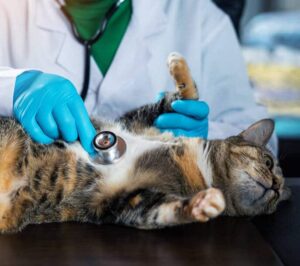
How Will My Veterinarian Determine That My Cat Has FIP?
The wet form of FIP is relatively straightforward for your veterinarian to diagnose. Young cats arriving with low-grade fevers and fluid accumulations in their chest or abdomen or both are likely to have this disease. Blood samples your veterinarian obtains usually show mild to moderate anemia. Blood albumin levels are often low, A:G ratios are off, blood globulin levels are often high, giving an albumin to globulin ratio of <0.6. However, these tests serve better as a rule-out test than a rule-in test. (read here) Total lymphocyte counts are often low and neutrophil counts elevated. Examination of the specific gravity of the fluid confirms that it is an inflammatory exudate (> 1.030).
When a cat has developed the dry form of FIP, diagnosis is much more challenging. High blood globulin levels (hyperglobulinemia) – often combined with low blood albumen levels, are suggestive of FIP. Tissue biopsies, can confirm the disease with certainty, but they can be challenging or impossible to safely obtain. Advanced centers have found MRI imaging and spinal fluid analysis useful tools. (read here & here)
Most veterinarians make a dry-form FIP diagnosis based on a preponderance of evidence – not 100% certainty. Preponderance of evidence is a very relative term. It is probably what accounts for the miracle FIP cures that are reported now and then. Just because a cat is coronavirus positive and has some of the common symptoms of the dry form FIP does not mean that FIP is the cause of its illness. None of the more common tests taken alone can confirm that a cat has dry form FIP. But several, taken together with the symptoms your cat is experiencing, are usually sufficient for your veterinarian to make a reasonable diagnosis. Even the presence of coronavirus antibodies, or the coronaviruses themselves, is insufficient, since so many healthy cats harbor that virus and anti-coronavirus antibody levels do not correlate well with FIP disease.
Some, including Idexx Laboratories, believe that high FCoV antibody titers add to an FIP presumption. In 2014, the Company introduced their FIP Virus RealPCR™ test that claimed to be able to tell (differentiate) the mild FCoV coronavirus from the mutated FIP coronavirus. The test was designed based on some German studies. (read here, here & here) However, more resent studies not paid for by Idexx have cast considerable doubt on the value of their patented test. (read here)

What Treatments Can My Veterinarian Offer My Cat?
GS-GC-376, GS-441524, and GS-5734 (remdesivir)
I do not know of another event in veterinary medicine that generated as much intrigue and commotion as what transpired after Dr. Niels Pedersen, a sincere, and highly competent veterinary virologist at Davis, and his associates, through good fortune, became aware of a Kansas State veterinarian’s 2013 study that certain protease inhibitors discovered in her search for medications that might help treat human norovirus infections, were also active against coronavirus. The ones found to be active against coronavirus were GC-376, GS-441524, and GS-5734 (both remdesivir). (read here & here)
Results of their combined efforts with Dr. Pedersen’s laboratory were very promising. (read here) It was a stellar breakthrough in feline veterinary medicine, although the medication appeared to be more effective in treating the wet than the dry form of the disease. However, at that point, greed entered the picture. The pharmaceutical companies that owned the patents on those medications saw much bigger profits selling them for human disease rather than for cats. That became paramount after the emergence of Covid-19 in 2019. Consequently, desperate cat owners were forced to turn to black market Chinese chemical laboratories that operate in defiance of international patent law. Like any underworld operation, you never knew what you would get. At one time, backstreet Chinese laboratories were selling their product for ~$4,000 for a supply adequate for a 6.6/3 kg cat. A cat owner in Russia told me in 2021 that the price in Moscow had dropped to $1,000 and another in China wrote to me that it was even less expensive there.
Several years have gone by since then, for current cost and suppliers, you need to go to chat sites like SOCK FIP. An Ohio State Veterinary School study in 2022 found that among cat owners, medicating their cats with GS-441524/ GC376 (remdesivir), obtained through various methods, the dosage they gave ranged from 2 mg/kg to 10 mg/kg with the most frequent dose being 5–6 mg/kg (eight cats) and 10 mg/kg (seven cats). Most gave the drug to their cat once a day. Most continued their daily treatment for ~twelve weeks. Some weighed their cats frequently, they were often thin to begin with and gained weight, so their dose needed to be adjusted upwards as time went by. Other owners upped their cat’s dose because it didn’t appear to be recovering. (read here) In another report, dosages of GS-441524 given ranged from 4–5 mg/kg up to 15 mg/kg, with the most common dosages used being 7–8 mg/kg and the highest being 15 mg/kg. (read here) European veterinarians have been known to give GS-441524/ intravenously for a few days when cats arrive at death’s doorstep.
An article that appeared in 2021 sent survey emails to 393 cat owners who thought that they had purchased injectable GS-441524 or something similar online. The minimum time they injected their cats was 12 weeks. Only 8.7% engaged the services of a veterinarian, so how many of those cats actually had FIP was unknown. The mean cost of the drug they purchased was $4,920. Most cat owners thought their cats got better after taking the medication. Fifty-four percent felt that their cat had been cured, 12.7% of the cats relapsed and 3.3% passed away despite receiving the medication. The most common problems in giving the medication that they reported were meowing, pain, struggling and injection site wounds. (read here)
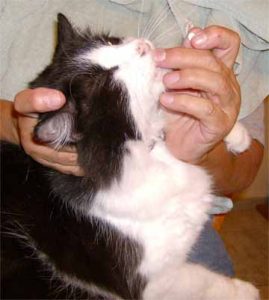
What About Giving These Drug Orally?
GS-441524 appears to also effective when you give it to your cat orally, although I suggest that your cat receive it by injection for at least its first week. A major advantage is that you do not have to give your cat injections. The injectable forms of the drug are very basic, so the injections sting. The possibility of injection induced fibrosarcomas has also been discussed. Oral GS-441524/remdesivir is apparently a component of Xraphconn® (aka Mutian®X ?) produced in China – although they call their active ingredient MT-0901. They have added a number of other ingredients that have never been shown to be helpful to cats with FIP, but the GS-441524/remdesivir that is in it can be effective when given orally. In one study, 18 cats thought to be suffering from FIP were given this product. If they had the dry form of FIP (two did) they were given 10 mg/kg/day of Xraphconn®. If they had the wet form of FIP, they received 5 mg/kg/day. They were treated daily with the drug for 83 days. As with the injectable form, the amount to give was recalculated every day based on any changes in the cat’s body weight. The cats were kept at the vet hospitals for observation during their first week. All 18 cats were said to have completely recovered within the 84 days of treatment. One problem is that no one, outside of those who cooked up this product in China, know how much GS-441524 is in each tablet. (read here) Many European vets prefer switching to oral GS-441524 after a few days of injections, or as soon as the cat is not too dehydrated to swallow the pills or capsules. They cite better compliance, less pain to the cat, cost to the cat owner with no difference in success rates over injectable GS-441524 as the reasons. However, they mention that they suspect that some of these illegally obtained products contain less GS-441524 than written on their labels. If they are giving a high-end dose due to it being a neurological case, they split the day’s dose into a morning and evening portion for the full 12-week treatment.
Molnupiravir
Molnupiravir (Lagevrio® aka HERO Plus 2801 aka Aura 2801) is a medication that was originally developed to treat the flu (human flu, not cat flu). It is most commonly used today to treat COVID-19. It can be legally purchased and dispensed “off label” by veterinarians. In 2022, a group of veterinarians at the vet schools in Ohio and Virginia published an experimented using molnupiravir to treat cats with FIP. Particularly, in FIP cats that had failed to benefit from GS-441524 or relapsed after taking it. Of those cats, one was also FeLV positive, three had symptoms of both the dry and wet (non-effusive) form of FIP, two had only the dry ocular form and the rest of the cats had the wet (effusive) form of FIP. These Veterinarians still recommended that GS-441524 be attempted first and present molnupiravir as a “rescue therapy”. Each of 26 cats diagnosed as having FIP received 12.8 mg/kg twice a day at first. By the time the molnupiravir treatment ended (12.5 weeks later) they were receiving an average ending dosage of 14.7 mg/kg twice daily. Twenty-four of the 26 cats were still living disease-free at the time of their writing. They saw few side effects during treatment: folded ears (1), broken whiskers (1), and one cat that developed a very low WBC count (=leukopenia) when given a dose of more than 23 mg/kg twice a day. For four other cats, economic restraints prevented them from purchasing GS-441524. One of those cats received 12 mg/kg oral molnupiravir twice daily and became free of symptoms for less than one week before relapsing. So, its dose was increased to 19 mg/kg twice daily for another 10 weeks. (read here)
Unpublished data from HERO Plus 2801 Chinese manufacturer whose background I do not know is said to suggest a dose of their product at 30-40 mg/kg every 24 hours or 15-20 mg/kg twice a day. For reference, the suggested human dose for Lagevrio®, that contains the same or similar active ingredient, is about 12 mg/kg twice daily.
Molnupiravir As A First-Line Therapy
The authors of the same study, also gave molnupiravir (Aura 2801) to four cats that had not received GS-441524 in the past. These were cat owners who did not have the money needed to purchase it. The average starting dose was 11.75 mg/kg, given twice daily (with a range 8–19 mg/kg). By the end of the study, the amount given twice a day had risen to 12.25 mg/kg twice daily (range of 8–19 mg/kg). The cats received this medication for 10 to 13 weeks, with the average being about 12 weeks. All cat owners reported seeing improvement in their cat’s health within the first two weeks. All four cats survived treatment and, according to the authors, were disease-free at the time they published their results. It will take more feedback from cat owners to judge this drug’s effectiveness. If you elect to use molnupiravir as the first line therapy for your cat with FIP, please let me know the results. I will anonymously add them to the bottom of this page.
Mefloquine
Mefloquine is an anti-malarial drug, sold under the name Lariam®, among others. It’s been in use for that since 1974, when it was developed with the aid of the US Army. In 2020, it was suggested that the drug, and similar anti-malarial drugs such as chloroquine, might have antiviral and anti-inflammatory properties and useful in treating Covid-19 and SARS. (read here) Not all agree with the safety or efficacy of these antimalarial medications. (read here & here) They do inhibit coronavirus multiplication in test tubes, but what they might do in the body remains unknown. Everycat.org granted a group of research veterinarians in Australia $11,750 in 2016 to see if mefloquine had the ability to cure FIP. In the lab, it performed as well in killing feline coronavirus just as it did in humans in killing Covid virus. (read here) However, if the Australians ever got around to trying it as a cure for FIP cats, they did not disseminate those results. Yet in 2023. In 2020, the FDA revoked the experimental use of this class of drugs to treat Covid-19 because studied found no benefit, and possible harm in giving them. (read here) Nevertheless, In Europe and the UK, some veterinarians still treat FIP with mefloquine. When they do, their dose is said to be 6.2.5 mg two to three times a week or 20-25 mg once a day. The tablets are apparently bitter. Vomiting is the most common side effect mentioned. I would avoid administering this product to a cat.

None of these drugs are free of potential risks. However, not giving them, if your cat really has FIP, is a verified fatal risk. If you are reading this article, you are probably not a veterinarian. You will be flying by your own pants. Occasional skin reactions, sensitivity and sores occur at the injection sites. Infrequently, they have been severe, due to poor injection technique. Minor kidney damage was once attributed to one of the Chinese knockoffs. The severity of your cat’s condition at the time you start these drugs greatly affects your cat’s chances of success. Some of these cats require fluid therapy. Many have multiple health issues that only a veterinarian is qualified to address – performing things such as CBCs, blood chemistry panels, A:G ratios etc. But as important as those tests are, a good appetite, progress in returning to your cat’s traditional weight, and a slow return of your cat’s old cheerful self are even better signs.
If your cat won’t eat, I believe that a few days of corticosteroid (e.g. prednisolone) is permissible. But try some boiled chick and broth or its favorite treats first – not something industrially prepared. Non-steroidal appetite stimulants such as Mirataz® or Elura® are also available. The drawback of Elura® is its unpleasant taste. If you have given either to your FIP+ cat, please let me know how that turned out. Some cat owners throw in liver or kidney tonics such as SAMe, silymarin /=milk thistle, S-Adenosylmethionine, probiotics, vitamin B3, etc. But I do not believe that any of those products will affect our cat’s outcome.
Treatments I Have No Faith In
For many years, I have believed that the FIP “cures” that are occasionally reported probably represent cases where cats were carrying only the non-fatal intestinal form of coronavirus but exhibited signs similar to FIP because of some other unrecognized health problem(s). I believe that the folks at Davis share that opinion. In no report that am aware of was it ever verified that the coronavirus had left their intestine and invaded the cat’s body. (monocyte/macrophage tropism). That is something that, we believe, has to happen before your cat develops FIP.
Polyprenyl Immunostimulant (PPI) (aka polyprenyl phosphate, Fosprenil®)
In 1996, the founders of a Russian startup company, Micro-plus, published an article on the astonishing abilities of their compound, polyprenyl phosphate (phosprenyl, aka fosprenil) to cure a wide variety of diseases. Read that study here. They claimed its use to be “highly efficient” in the treatment of rabies, cancer, distemper, hepatitis, enteritis (parvo?) and potentially useful in treating human HIV and human herpes too. They obtained a Russian patent on the compound. Polyprenyl immunostimulant (PPI) is still widely sold in Russian pet stores, where it is still billed to cure most anything. See here. I remain skeptical that polyprenyl immunostimulant is of any value to your cat. The last time I know that a claim that broad was made for a potion was by Mithridates the Great in 100 BC. Read more about the Great Theriac if you wish to here. Nevertheless, in 2009, veterinarians at the University of Tennessee reported that PPI seemed to benefit several cats that were assumed to have the dry form of FIP. (read here) Naturally, everyone was elated and hopeful. Even the Winn Feline Foundation contributed some money. But since that initial announcement in 2009, I know of no further publications on this medication in human or animal medicine. As a rule of thumb, truly effective medications that are this urgently needed by veterinarians and cat owners catch on considerably faster. Read a Russian veterinarian’s 2013 opinion on the questionable value of PPI in the treatment of FIP here.
Feline Interferon Omega
Interferons play a part in your cat’s natural resistance to corona and other virus. (read here) So one might assume that administering interferon to cats with FIP might help them. A Japanese study once suggested that. (read here) However, it was a poorly constructed study. Only a few animals were treated and observed, and there was never proof offered that any of the cats suffered from FIP. But since veterinarians had so little to offer FIP cats, it caused a lot of excitement at the time.
A more recent German study found that feline interferon administration had no effect on how long a FIP-infected cat lived or the quality of its life. (read here) I suppose one can always argue that the Germans didn’t give enough interferon, or gave it the wrong way, or gave it at the wrong stage of the disease, etc. So, there are still some veterinarians who administer it or recommend it. Virbac Corporation’s European division still markets a recombinant feline interferon product (Virbagen Omega®). It is not currently sold in the United States, but some North American cat owners manage to get their hands on it. A UK veterinarian published an article in 2020 that suggested its use was beneficial in aiding a cat infected with the dry form of FIP. However, besides the interferon omega, the cat received the Chinese brew, Mutian. (read here) My belief, the belief of the NIH, and others is that these commercially available interferon products have no ability to cure coronavirus and probably do not affect the eventual course of FIP, FeLV or FIV either. (read here, here & here) Another one with similar claims, Feliferon®/Felifer®, is or was sold in Russia and online.

Can My Cat Be Vaccinated Against FIP?
Yes.
An intranasal vaccine against FIP has been around for a long time. It was originally developed by Fort Dodge, Animal Health, but that company was purchased by Pfizer in 2009, which in turn split off its animal products as Zoetis. Who now sells the product as Felocell FIP®. It is FDA licensed as drops that are placed in your cat’s nose. The live virus it contains is bioengineered not to survive at your cat’s internal body temperature. Its nasal lining is, however, cooler, so it can proliferate there. There is a great deal of controversy as to the worth of this vaccine, since there is no scientific way to determine its effectiveness. That would require a way to reliably produce FIP in a group of vaccinated and unvaccinated cats. Cats that receive this vaccine do, however, produce antibodies against coronavirus. Perhaps that would protect them if, later in life, they were exposed to coronavirus, or, perhaps, it might make them less or more susceptible to developing FIP. We really do not know. The other problem is that the vaccine direction require your cat to be 16 weeks of age before the nose drops are given. Earlier than that, kittens apparently do not respond to the vaccine with antibodies. By the time they are 16 weeks old, many kittens have already been exposed to coronavirus – either from their mothers or from surrounding cats. Some also believe that the duration of protection, if any, that this vaccine produces is quite short. It might be of some use when a new coronavirus antibody-negative cat is being introduced into a household or cattery that is known to harbor coronavirus. But no one really knows. Current 2023 AAHA guidelines are that this vaccine is “not generally recommended“.

While updating this article in July of 2023, a Google Adsense ad kept popping up from MAXPAW. I have an Adsense account to help pay my website expenses. Adsense ads are at the bottom of all my webpages, as you can see. If you have used that companies services, I would like to know if you were satisfied with their services. Thanks RSH
You are on the Vetspace animal health website
Visiting the products that you see displayed on this website help pay the cost of keeping these articles on the Internet.

